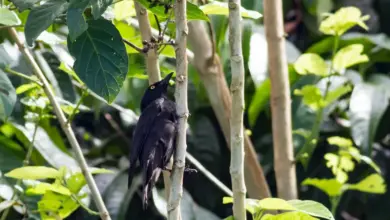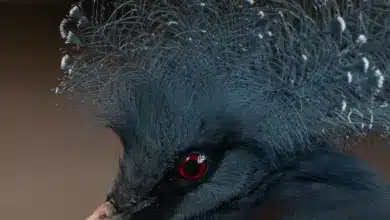Northern Mockingbirds, Mimus polyglottos
The Northern Mockingbird, Mimus polyglottos, is the only mockingbird commonly found in North America. This species was first described by Linnaeus in his Systema naturae in 1758 as Turdus polyglottos.
This bird has been officially named the State Bird of Arkansas, Florida, Mississippi, Tennessee, and Texas (USA).
Distribution / Range
The Northern Mockingbird breeds in southeastern Canada, the United States, northern Mexico, the Bahamas, the Cayman Islands, and the Greater Antilles.
It is replaced further south by its closest living relative, the Tropical Mockingbird. The Socorro Mockingbird, an endangered species, is also closely related, contrary to previous opinions.
This bird is mainly a permanent resident, but northern birds may move south during harsh weather.
This species has occurred in Europe as an extreme rarity.

These birds forage on the ground or in vegetation; they also fly down from a perch to capture food. They mainly eat insects, small frogs, lizards, berries, and seeds. While foraging they frequently spread their wings in a peculiar two-step motion to display the white patches. There lack of consensus among ornithologists over whether this behavior is purely a territorial display, or whether the flashing white patches startle insects into giving up their cover.
Mockingbirds’ willingness to nest near houses, their loud and frequent songs, and their territorial defense often annoy people. John van der Linden, author of the Eastern Birding Central FAQ, reported that 25 to 50 percent of the e-mail questions he received were concerned with how to deal with annoying mockingbirds.
Mockingbirds have a strong preference for certain trees such as maple, sweetgum, and sycamore. They generally avoid pine trees after the other trees have grown their leaves. Also, they have a particular preference for high places, such as the topmost branches of trees. Mockingbirds are often found in urban and suburban areas, where they perch on telephone poles, streetlights, or high points in buildings. While singing on a high perch they will often bolt several feet into the air in a looping motion, with wings outstretched to display their white underside, then land back on the perch without breaking a note. This has been studied and thought to be a courtship display.
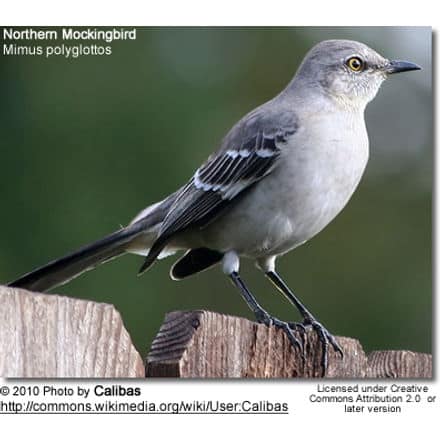

Northern Mockingbird males establish a nesting territory in early February. If a female enters his territory, the male will pursue the female with initial aggressive calls and, if she becomes disinterested, with softer calls.
Once the pair is established, their song becomes more gentle. Northern Mockingbirds tend to be monogamous, and the female may return to the same male from the previous season.
Both the male and female Northern Mockingbird are involved in the nest building. The male does most of the work while the female perches on the shrub or tree where the nest is being built to watch for predators. The nest is built approximately 3 to 10 feet above the ground. The outer part of the nest is composed of twigs while the inner part is lined with grasses, dead leaves, moss, or artificial fibers.


The eggs are a light blue or greenish color and speckled with dots. Approximately three to five eggs are laid by the female, and she incubates them for nearly two weeks. Once the eggs are hatched, both the male and female feed the chicks.
The birds aggressively defend their nest and surrounding area against other birds and animals. When a predator is persistent, mockingbirds from neighboring territories, summoned by a distinct call, may join the attack.
Other birds may gather to watch as the mockingbirds harass the intruder. In addition to harassing domestic cats and dogs they consider a threat, it is not unheard of for mockingbirds to target humans. They are absolutely unafraid and will attack much larger birds, even hawks.
One famous incident in Tulsa, Oklahoma involving a postal carrier resulted in the distribution of a warning letter to residents.
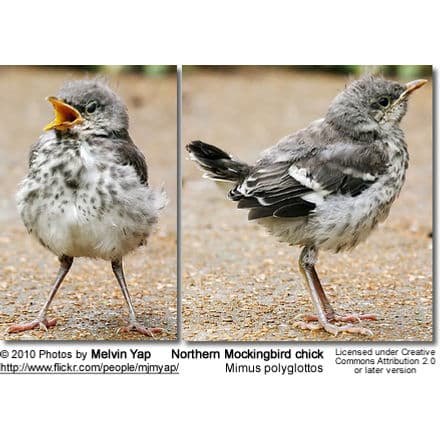
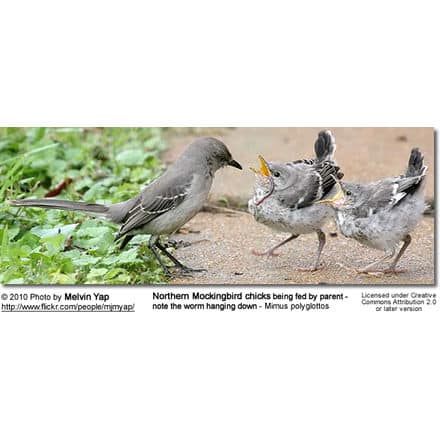

Song and calls
Although many species of bird imitate other birds, the Northern Mockingbird is the best known in North America for doing so. It imitates not only birds but also other animals and mechanical sounds such as car alarms. As convincing as these imitations may be to humans, they often fail to fool other birds, such as the Florida Scrub-Jay.
The Northern Mockingbird’s mimicry is likely to serve as a tool for increasing the size of its repertoire and thus its ability to attract females. The mockingbird is limited to imitating short units of sound, which it repeats several times before moving on to a new sound. As a result, the mockingbird sounds much better (to a human ear) imitating some species than others. Species with repetitive songs, such as the Carolina Wren, are effectively copied, but species with long, complex songs, such as the Song Sparrow, cannot be effectively imitated by the mockingbird.
The Northern Mockingbird, in addition to being a good mimic, is also one of the loudest and most constantly vocal of birds. It often sings through the night, especially unmated males, or when the moon is full. It sings year-round except sometimes for the late-summer molting season. Individual males have repertoires of 50 to 200 songs; females sing as well, but more quietly and less often than males. Mockingbirds usually sing the loudest in the twilight of the early morning when the sun is on the horizon.
In addition to its well-known song, the Northern Mockingbird utilizes a variety of calls to communicate specific information. As with its song, these calls are among some of the louder sounds produced by birds of its size. Mockingbirds make a harsh, raspy noise when chasing other birds out of their territory. A similar but distinct call is used when defending against predators like a hawk or falcon. Other calls include a wheezing noise, a “chuck” note, and a very piercing series of notes “high low” repeated twice.
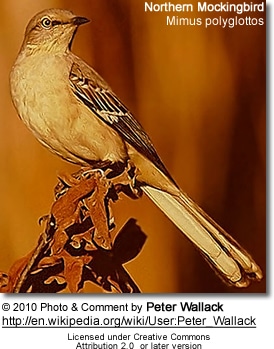
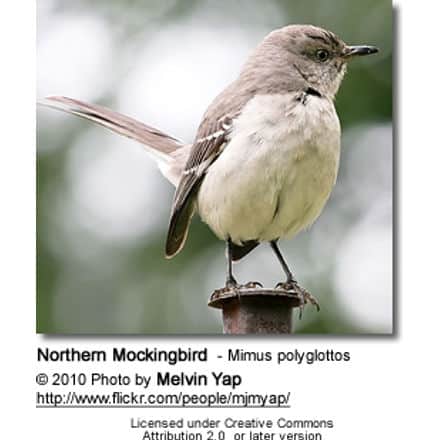
-
- It features in the title and central metaphor of the novel To Kill a Mockingbird, by Harper Lee. In the said novel, mockingbirds are portrayed as innocent and generous, and one of the major characters (Atticus Finch) says that it is a sin to kill a mockingbird.
- The traditional American lullaby “Hush Little Baby” has been recorded in numerous musical styles. The lyrics refer to the fact that Northern Mockingbirds were once popular as pets and begin:
- President Thomas Jefferson had a pet mockingbird named Dick.

Mockingbirds … Mimus
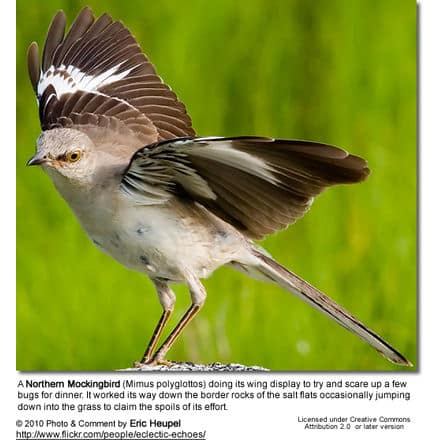
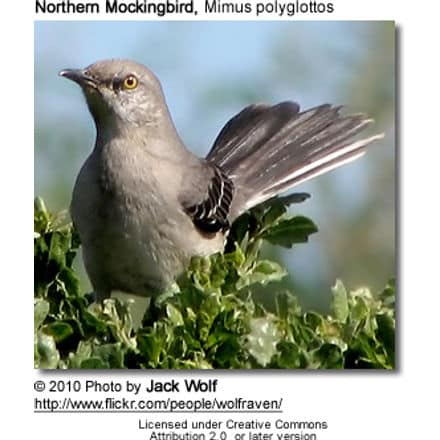

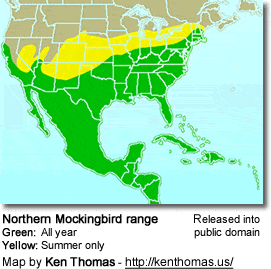
 The eggs are a light blue or greenish color and speckled with dots. Approximately three to five eggs are laid by the female, and she incubates them for nearly two weeks. Once the eggs are hatched, both the male and female feed the chicks.
The eggs are a light blue or greenish color and speckled with dots. Approximately three to five eggs are laid by the female, and she incubates them for nearly two weeks. Once the eggs are hatched, both the male and female feed the chicks.